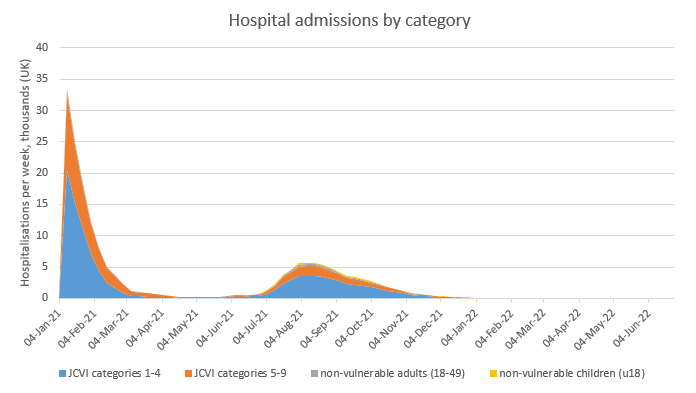
Lots of people asking: what does your model say about the delayed vaccine schedule? Can we still unlock on the planned dates?? So here goes with an emergency model update. Summary: don’t panic, it will be OK. 1/n
So just a reminder of my current model ‘base case’ (with R0 for the new variant now set to 4, following comparison with the Warwick/Imperial models). This has a relatively small ‘exit wave’ next winter, with ~10k deaths. 2/n 

If we knock 10m doses out of the vaccine schedule in April (reducing my expected 4m per week estimate to 2m per week), we get a slightly stronger and earlier ‘exit wave’. But total deaths after March are not much higher at ~13k. 3/n 

In reality I think it’s likely that a small dose of seasonality would knock that wave back into the autumn/winter, and that buys us time to vaccinate some more people (including teenagers) – and the exit wave is removed. 4/n 

So that’s no big problem, and no reason to delay implementation of the roadmap on its current schedule – although it may make acceleration of the schedule less likely, as we’ve used up a lot of the ‘slack’ or contingency that previously existed. 5/n
OK, but what if April isn’t the end of it? What if vaccine supplies continue to be interrupted through May as well? Fine, let’s knock another 10m doses out of our schedule, so that 2m per week continues to early June: 6/n 

So that’s maybe more of a problem, we now have an exit wave peaking not much lower than January’s crisis, with a total of ~25k deaths after March. That’s the sort of thing that might get the govt to think about delaying the unlocking roadmap. 7/n
But again, there’s a few ways to deal with this. A mild dose of seasonality, plus vaccinations of teenagers, still kills off the exit wave: 8/n 

If you don’t want to rely on seasonality, you could keep some ‘baseline controls’ going over the summer (here we’re talking about TTI, masks, maybe limits on large indoor events). That should be enough to moderate the wave, and bring it inside NHS capacity, with ~11k deaths: 9/n 

Or you could note that we also got some good news today from PHE’s summary of vaccine effectiveness, which showed VE of 72% / 85% against infection after 1 dose / 2 doses. I haven’t changed my central case for that yet because it was a study done in 10/n assets.publishing.service.gov.uk/government/upl…
...healthcare workers, who (I think) mostly got Pfizer. So it may not reflect what we get in the whole population, where AZ has been more common. But it’s a possible upside. And the impact would be enough, again, to squash most of the exit wave (~7k deaths) 11/n 

So, even with a vaccine drought lasting through April and May, we still get only a moderate exit wave, which could be managed using moderate ‘baseline’ controls – and that’s if it doesn’t get squashed by seasonality, or slightly higher vaccine efficacy than I’ve assumed. 12/n
So in my view there's no reason to get depressed, no reason to abandon the ‘unlocking’ schedule, and every reason to stay positive, be patient, and take the vaccine as soon as it’s offered. We’ll beat this thing in the end. 13/n
• • •
Missing some Tweet in this thread? You can try to
force a refresh










